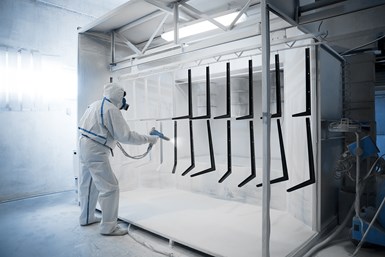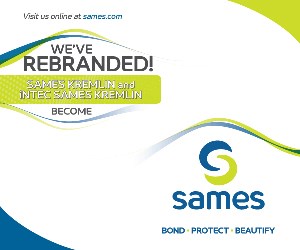Powder Coating Is a Process
There’s more to powder coating than picking up a powder gun and getting to work. John Cole of Parker Ionics discusses how to go about getting started with the powder coating process properly, from initial education to working with suppliers.

Q. I’m thinking about getting into powder coating. What steps are necessary to get started properly?
A. Great question and I’m glad you want to “get started properly.” We get a lot of calls from people and companies that, for various reasons, want to get into powder coating. I always respond with the initial comment that “powder coating is a process.” It has a lot of moving pieces and all must be managed properly to do it correctly. My first suggestion is to attend a high-quality powder coating training class such as the Powder Coating Institute’s 101 and 202 courses. They are held regularly and one or the other is available every month.
After that, I tell everyone that the two most important people you need to have a relationship with are your powder salesperson and your pretreatment chemical salesperson. You need to have a strong, trusting relationship with both. In the powder coating process, they have a long-term, steady, day-to-day, week-to-week vested interest in your success. Trust me, they will become your best friend and ally. I was very careful and purposeful in saying powder or chemical “salesperson.” The fact is that at the corporate nameplate level, there is not a significant difference among the big players in our industry (I can hear all the powder and chemical companies simultaneously growling at me). They are all great (hope that settles them down). My point is as a startup, you are more likely to be helped by the local salesperson than the corporate office.
On the “powder” side of the equation, I have one bit of expert advice: Be careful what you ask for. All too often, the question asked of powder companies is to lower the powder cost. A few cents here or there is manageable. Beyond this and you are cutting into margins and corporate sustainability. This is a dangerous, slippery slope to go down. Reputable powder companies have outstanding polymer chemists working for them. Challenge them for lower-cost powders (without any other constraints) and they can certainly develop it. Go down this path and I guarantee you will not be happy. The result is almost always a higher specific gravity powder that is harder to fluidize and also covers significantly less sq. ft. of metal per pound. The end result is a higher total cost of coating that affects your company’s profitability.
Whether you are a job shop coater or a captive powder coater, the process is essentially the same. A job shop is one where the coating is being done for outside customers. Generally, job shops do not manufacture anything, but rather simply add value to their customers’ products by providing coating services. Captive powder coating is done by manufacturers in-house as part of their manufacturing process. The main difference is the wide variety of coating processes done in job shops, whereas captive powder coating operations are well defined and vary little from day to day.
I was recently at a captive powder coating shop following the installation of its new wash bay, powder booth and oven. Standing there with the plant manager, he turned to me and asked, what’s next? In my mind, the answer was simple — start powder coating. I quickly realized he had no basis to know what was next and he was asking me where to start. He had taken a training class that I knew to be high quality, but the reality of now being on his own had set in. Fortunately, I did notice earlier they had bought some boxes of powder. I suggested we get the tech rep for the powder company to come in to do some training and run a temperature profile of the new oven. This same customer had also contacted and developed a relationship with the pretreat chemical company local salesperson, so the wash system was ready to go.
The next day, both the powder company tech service guy and the chemical tech guy were on site. While the chemical technician was setting up the wash wand system, the powder technician was running a series of temperature profiles for the oven. Normally the powder tech would then train the coaters on powder gun setup and use, but since I was there, we were able to do all three functions simultaneously. This all took place in the morning and by mid-afternoon, the customer’s coaters were well on their way to producing quality parts for their products.
Hopefully, you recognize that there is more to powder coating than picking up a powder gun and spraying powder. It truly is a process and requires a knowledge of all sub-processes to succeed. Working with high-quality supplier companies and their local support can make the process of getting into powder coating successful.
About the Author
Related Content
Masking Solutions for Medical Applications
According to Custom Fabricating and Supplies, a cleanroom is ideal for converting, die cutting, laminating, slitting, packaging and assembly of medical-grade products.
Read MoreTrivalent Chrome Overview
As the finishing industry begins to move away from the use of hexavalent chromium to trivalent chromium, what factors should finishers consider as they make new investments? Mark Schario, chief technology officer for Columbia Chemical offers a helpful overview of this complicated topic.
Read MorePrevent Plating Problems with Critical Inspections
Tanks and their contents should be regularly inspected visually and analytically. When a quality issue arises, it is important to quickly pinpoint where the main problem is by checking which parameter is out of line.
Read MoreHow to Address Declining Powder Coating Coverage Over Time
Fine particles from reclaim could be to blame for powder coating problems that emerge over time. Avoid problems by keeping hooks clean, maintaining guns and using reclaim powder quickly to avoid accumulation of fines.
Read MoreRead Next
Do You Have Good Ground?
John Cole, president of Parker Ionics, discusses his favorite subject: why having a good ground is so important for your powder coating process.
Read MoreTruly Investing in Training
John Cole of powder coating equipment supplier Parker Ionics discusses how to get a worthwhile return on your investment in employee training.
Read MoreEducation Bringing Cleaning to Machining
Debuting new speakers and cleaning technology content during this half-day workshop co-located with IMTS 2024.
Read More














.jpg;maxWidth=300;quality=90)






